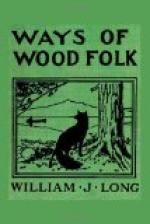The habit of hiding becomes so fixed with the young birds that they trust to it long after the wings have grown and they are able to escape by flight. Sometimes in the early autumn I have run the bow of my canoe almost over a full-grown bird, lying hidden in a clump of grass, before he sprang into the air and away. A month later, in the same place, the canoe could hardly approach within a quarter of a mile without his taking alarm.
Once they have learned to trust their wings, they give up hiding for swift flight. But they never forget their early training, and when wounded hide with a cunning that is remarkable. Unless one has a good dog it is almost useless to look for a wounded duck, if there is any cover to be reached. Hiding under a bank, crawling into a muskrat hole, worming a way under a bunch of dead grass or pile of leaves, swimming around and around a clump of bushes just out of sight of his pursuer, diving and coming up behind a tuft of grass,—these are some of the ways by which I have known a black duck try to escape. Twice I have heard from old hunters of their finding a bird clinging to a bunch of grass under water, though I have never seen it. Once, from a blind, I saw a black duck swim ashore and disappear into a small clump of berry bushes. Karl, who was with me, ran over to get him, but after a half-hour’s search gave it up. Then I tried, and gave it up also. An hour later we saw the bird come out of the very place where we had been searching, and enter the water. Karl ran out, shouting, and the bird hid in the bushes again. Again we hunted the clump over and over, but no duck could be seen. We were turning away a second time when Karl cried: “Look!”—and there, in plain sight, by the very white stone where I had seen him disappear, was the duck, or rather the red leg of a duck, sticking out of a tangle of black roots.
With the first sharp frost that threatens to ice over the ponds in which they have passed the summer, the inland birds betake themselves to the seacoast, where there is more or less migration all winter. The great body of ducks moves slowly southward as the winter grows severe; but if food is plenty they winter all along the coast. It is then that they may be studied to the best advantage.
During the daytime they are stowed away in quiet little ponds and hiding places, or resting in large flocks on the shoals well out of reach of land and danger. When possible, they choose the former, because it gives them an abundance of fresh water, which is a daily necessity; and because, unlike the coots which are often found in great numbers on the same shoals, they dislike tossing about on the waves for any length of time. But late in the autumn they desert the ponds and are seldom seen there again until spring, even though the ponds are open. They are very shy about being frozen in or getting ice on their feathers, and prefer to get their fresh water at the mouths of creeks and springs.




